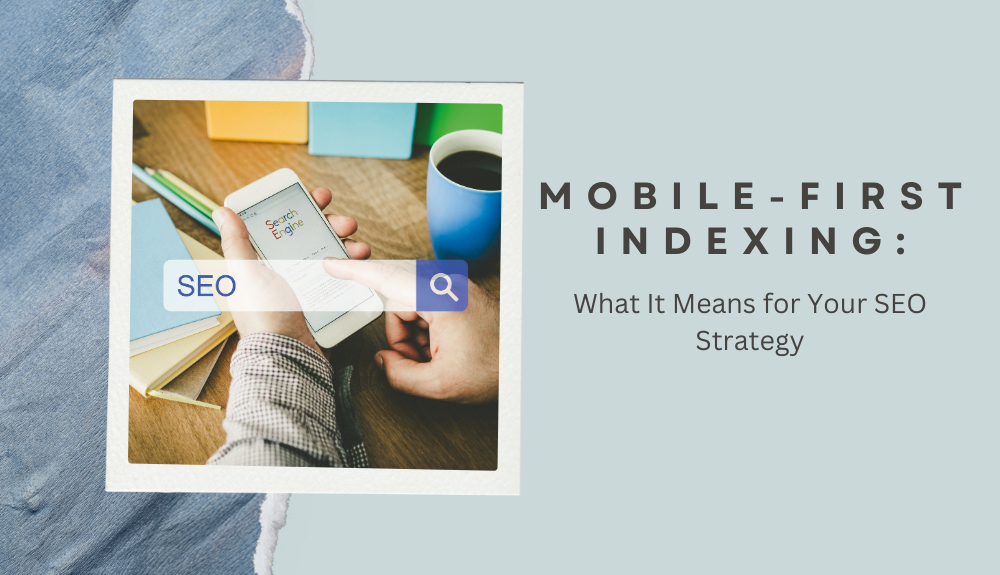As smartphones and mobile devices continue to dominate the way we access information online, Google’s Mobile-First Indexing has become a game-changer in the world of SEO. If you want your website to rank well and be visible to your target audience, understanding and optimizing for this shift is crucial. Let’s dive into what Mobile-First Indexing means for your SEO strategy and how you can stay ahead in the ever-evolving digital landscape.
Understanding Mobile-First Indexing
Mobile-First Indexing is Google’s way of prioritizing the mobile version of websites for indexing and ranking in search results. This means that Google now predominantly uses the mobile version of a site’s content to determine its position in search engine results pages (SERPs). In the past, Google primarily looked at desktop versions for this purpose. However, with the increasing number of users accessing the web on their phones, it makes sense for Google to shift its focus to mobile.
For website owners and SEO professionals, this shift underscores the importance of having a responsive and mobile-friendly design. Your site needs to offer a seamless user experience on smaller screens to rank well in searches. By ensuring that your website looks great and functions smoothly on mobile devices, you can improve your chances of ranking higher and reaching more potential customers.
How It Affects Your SEO Strategy
As Google shifts towards mobile-first indexing, your SEO strategy needs to adapt. This change means that the search engine primarily uses the mobile version of your site for ranking and indexing. It’s no longer just about desktop optimization; mobile performance is crucial.
Mobile-first indexing impacts how Google evaluates and ranks your website. If your site isn’t optimized for mobile devices, it could negatively impact your search rankings. This shift emphasizes the importance of responsive design, fast loading times, and a seamless user experience on smartphones and tablets.
To stay ahead in SEO rankings, prioritize mobile optimization strategies like optimizing content for smaller screens, improving page speed, utilizing responsive design techniques, and focusing on user-friendly navigation. By ensuring that your website is fully optimized for mobile users, you can enhance visibility and reach more potential customers online.
The Importance of Mobile Optimization

In today’s digital age, mobile optimization is no longer just a nice-to-have; it’s a must for any website looking to succeed online. With the majority of internet users browsing on their mobile devices, ensuring your site is optimized for mobile is crucial.
Having a mobile-friendly website not only improves user experience but also boosts your SEO rankings. Search engines like Google prioritize websites that are optimized for mobile in their search results, giving them an edge over those that aren’t.
Mobile optimization involves creating responsive designs, fast loading times, and easy navigation tailored to smaller screens. By providing a seamless experience across all devices, you can attract and retain more visitors to your site.
Ignoring mobile optimization can result in high bounce rates and lower conversion rates as users struggle to navigate or access content on their smartphones or tablets. Stay ahead of the competition by prioritizing mobile-friendliness and watch your online presence flourish.
Tips for Optimizing Your Website for Mobile-First Indexing
Are you looking to boost your website’s visibility in mobile search results? Here are some essential tips for optimizing your site for mobile-first indexing.
First, ensure that your website is responsive and mobile-friendly. This means that it should adapt seamlessly to various screen sizes and load quickly on mobile devices.
Next, prioritize the user experience by simplifying navigation and making important information easily accessible. Mobile users expect a smooth browsing experience without having to pinch or zoom excessively.
Optimize your images and videos for mobile viewing by compressing files to reduce loading times. Remember, slow-loading content can drive users away.
Focus on creating high-quality, engaging content that is relevant to your target audience. Mobile users often have limited attention spans, so make sure your content is concise and easy to consume on smaller screens.
Regularly test your website across different devices and browsers to identify any issues that may affect its performance in mobile search results. By following these tips, you can enhance your site’s readiness for mobile-first indexing and improve its overall SEO strategy.
Common Mistakes to Avoid
When it comes to mobile-first indexing, there are some common mistakes that can negatively impact your SEO efforts. One of the biggest pitfalls is neglecting to prioritize mobile optimization on your website. If your site isn’t responsive or doesn’t load quickly on mobile devices, you could be missing out on valuable organic traffic.
Another mistake to avoid is using intrusive interstitials or pop-ups that hinder the user experience on mobile devices. These can frustrate visitors and lead to higher bounce rates, which in turn can hurt your search rankings.
Furthermore, failing to optimize your content for mobile consumption is a critical error. Make sure text is easily readable without zooming in and that buttons are large enough to tap with a finger. Ignoring these factors can result in a poor user experience and lower visibility in search results.
Overlooking the importance of local SEO for mobile users is a missed opportunity. Ensure your business information is accurate and consistent across all platforms to enhance your online presence and attract potential customers effectively.
The Future of Mobile-First Indexing

As technology continues to advance, the future of mobile-first indexing looks promising. With the increasing use of smartphones and tablets, Google’s emphasis on mobile-friendly websites is only going to grow stronger.
In the coming years, we can expect search engines to prioritize mobile-optimized content even more. This means that businesses will need to adapt by focusing on enhancing their mobile user experience and site performance.
Moreover, as voice search becomes more prevalent, optimizing for natural language queries will become essential for SEO success. Websites that are structured for voice search compatibility will have a competitive edge in the evolving digital landscape.
Additionally, with the rise of 5G technology, faster loading speeds and seamless user experiences on mobile devices will be imperative. Ensuring your website is not only responsive but also lightning-fast will be crucial for ranking well in search results.
Staying ahead of these trends and continually optimizing your website for mobile-first indexing will be key to remaining competitive in the ever-changing digital realm.
Conclusion
As Google continues to prioritize mobile-first indexing, it is crucial for businesses to adapt their SEO strategies accordingly. Mobile optimization is no longer just an option – it’s a necessity in today’s digital landscape. By focusing on creating a seamless and responsive mobile experience for users, you can improve your website’s search engine rankings and drive more organic traffic.
Remember, the key to success lies in understanding the importance of mobile-first indexing, optimizing your website for mobile devices, avoiding common mistakes, and staying ahead of future trends in this ever-evolving field. Embrace the shift towards prioritizing mobile users and watch as your SEO efforts pay off in increased visibility and engagement.
Stay proactive, stay adaptive, and most importantly – stay mobile-friendly!











